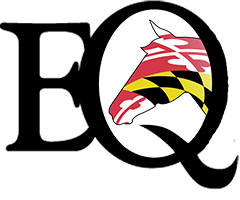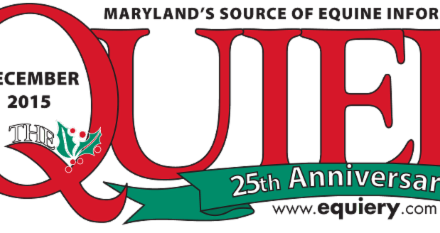by Karin De Francis, former co-owner of the Maryland Jockey Club (first published in the May 2019 Equiery)
There are few things in life blessed enough to survive World Wars, Depression, civil unrest and change, but the Preakness and Pimlico have done just that, gracing three centuries in Baltimore, while intricately weaving itself through the very social-economic-political fiber of our State…and the hearts of all Marylanders. Renowned for traditions whose observance connect us indelibly to the greats of yesteryear, the event and brand have also kept pace with current times. From the days when carriages, steam railways and electric trolleys brought fans to the oval affectionately known as “Old Hilltop,” to today’s expensive Teslas, people flock from across the country and around the globe to Preakness. Truly, “the eyes of the world” are on Pimlico every third Saturday in May.
After all, the American poet Ogden Nash once exclaimed, “The Derby is a race of aristocratic sleekness for horses of birth to prove their worth to run in the Preakness!”

Even though the original clubhouse burnt down in 1966, that section of the track at Pimlico is still referred to as the “clubhouse turn.”(photo provided by the Maryland Jockey Club)
Pimlico Race Course
It all started over cigars and brandy 151 years ago. It was 1868, just three years after Robert E. Lee surrendered to Ulysses S. Grant in Appomattox Court House, VA. The occasion was a grand dinner party attended by America’s elite, including Maryland Governor Oden Bowie, at the Grand Union Hotel in Saratoga, NY, home to the nation’s first racetrack. When lively debate centered on who could next build an impressive racecourse, Governor Bowie boldly picked up the gauntlet and true to his word, opened Pimlico Racecourse October 25, 1870, on 70 acres overlooking Jones Falls, where it sits today.
A popular theory behind the name choice came from English settlers’ reminiscence of London and “Olde Ben’s Pimlico Tavern.” The land was purchased for $23,500 – in 1869 the Maryland Jockey Club (MJC) leased the land from the original purchasers, the Maryland Agricultural Society, for annual rent of $1,000 – and the racetrack was constructed for $25,000.
Surprisingly, many complained the distance from the center of Baltimore to Pimlico was excessive, and suggested the location would serve better as a vacation destination, rather than a convenient racetrack! Eventually, the Western Maryland Railroad would carry passengers in 1881 on a spur line called Arlington + Pimlico, with its own station at Garrison Blvd. + Reisterstown Rd., and tracks that went right into Pimlico grounds.
The MJC – now the parent company of Pimlico Race Course and Laurel Park – is the oldest sporting institution in all of North America, founded in Annapolis in 1743, prior to the American Revolution. The Club has enjoyed a rich history filled with historic personalities who defined the country’s beginnings. After all, racing was “America’s first national past time.”
George Washington, a frequent enthusiast, reflected often in his diary of his days at the races in Maryland. Two signers of the Declaration of Independence, and President Andrew Jackson, who raced his White House stable under his secretary’s name, were MJC members. Governor Bowie and distinguished Baltimore movers and shakers were elected as MJC President and officials, respectively, in 1870.
As America’s second oldest racetrack, Pimlico is one of our great, venerated sporting institutions, home to racing’s most indelible memories, including an event hard to fathom in today’s politics. In 1877 the U.S. House of Representatives adjourned to join a crowd of 20,000 to watch the “Great Race of the Century” between Tom Ochiltree, Parole (the winner) and Ten Broeck. The political significance established Pimlico as the country’s top race course. The three horses are immortalized in an elegant reproduction on the exterior of the Clubhouse facing the main entry gate on Hayward Avenue.
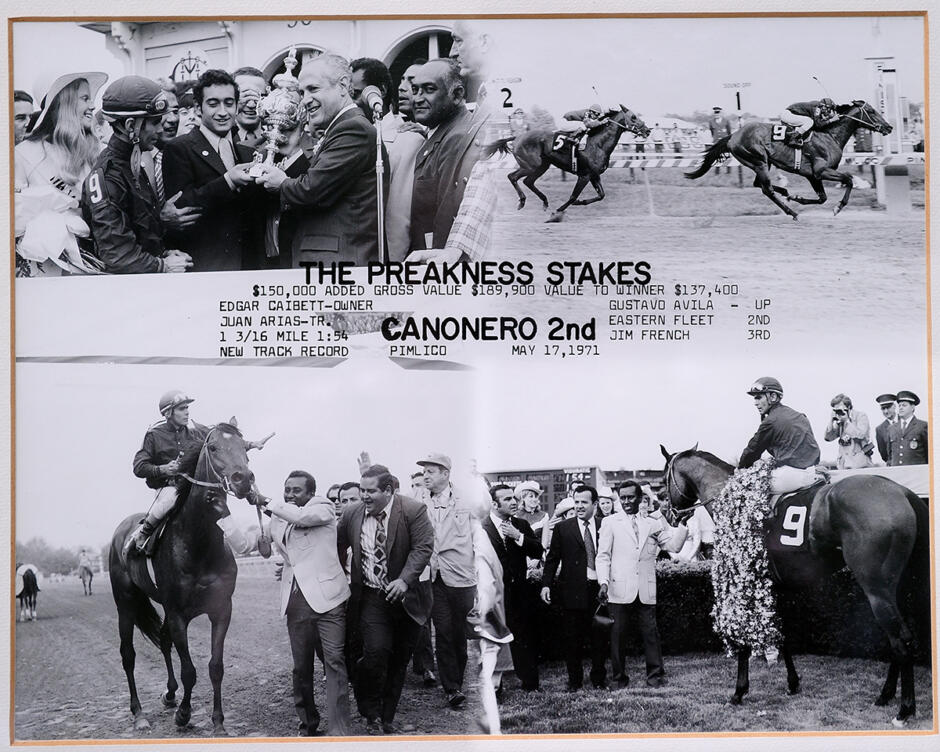
Fresh out of the U.S. Army, Maryland Jockey Club track photographer Jim McCue joined the team in 1970 making Canonero II’s 1971 Preakness Stakes win his first Preakness as a photographer. This year will be McCue’s 49th year shooting the Preakness Stakes. (photo by Jim McCue)
The Preakness Stakes Begins
To commemorate that prophetic Saratoga summer evening two years earlier, Opening Day at Pimlico featured the Dinner Party Stakes (now run as the Dixie Handicap on the turf). A large, ungainly bay colt (one of only two male starters in the seven-horse field) named Preakness, Native American for “quail woods,” won in front of 12,000 fans. Often referred to as just a “big cart horse,” he was named for owner Milton Sanford’s farm.
Pimlico’s adjacent street, Hayward Avenue, gained its moniker from his jockey, William Hayward. Legend has it the modern day references of finish line “wire” and “purse money” originated with Hayward at Pimlico, who untied the small silk purse with gold pieces from the wire stretched across the track from the judge’s stand to claim the winning prize.
At Governor Bowie’s request, and two years before the first Kentucky Derby, the Preakness Stakes debuted at Pimlico on May 23, 1873, and was won by Survivor, who galloped over his competition by 10 lengths, a record for 131 years until Smarty Jones’ romp by 11.5 lengths in 2004. The Preakness, set at 1.5 miles for three-year-olds and up, had a $50 entry fee and $2,000 purse – today the purse is $1,500,000! An iconic sporting legend was born.
The horse who lent his name to what became the Middle Jewel of Thoroughbred horse racing’s Triple Crown, and celebrates its 144th renewal this May 18, did not fare as well. Preakness raced through his eighth season, and then made his way to England where he became one of the first American horses afforded genuine recognition by the British. Purchased by a British Duke with a temper and a fondness for too much drink, the horse whose name is forever memorialized, was shot by the Duke in a drunken rage.
In 1889, due to changes in wagering and racing, the Preakness galloped to a halt in Maryland for 20 years. Before it returned for good in 1909 and without break to the present, New Yorkers were treated to Maryland’s “lost Preaknesses” at Morris Park in 1890, and for 15 years, at Brooklyn’s Gravesend racetrack. In the interim, Pimlico was home to a bit of steeplechase and harness racing, and a stint as Camp Wilmer, where the First Maryland Brigade trained for the Spanish – American War.
To herald the return of the Free State’s pride and joy on May 12, 1909, William R. Riggs – like the visionary MJC President Alfred Gwynne Vanderbilt in the 1930s – launched a number of valued traditions surviving today, specifically the singing of “Maryland My Maryland” during the post parade and the “painting of the colors” atop the weather vane to honor the winning horse.
Vanderbilt’s leadership brought Pimlico much success and renown. In the early days of movies and newsreels, to create unobstructed camera sight lines, he famously leveled the infield incline where carriages, motor cars and people clustered for the best view of the races, and gave rise to the popular “Old Hilltop.” The legendary 1938 Seabiscuit – War Admiral match race had been Vanderbilt’s brainchild.
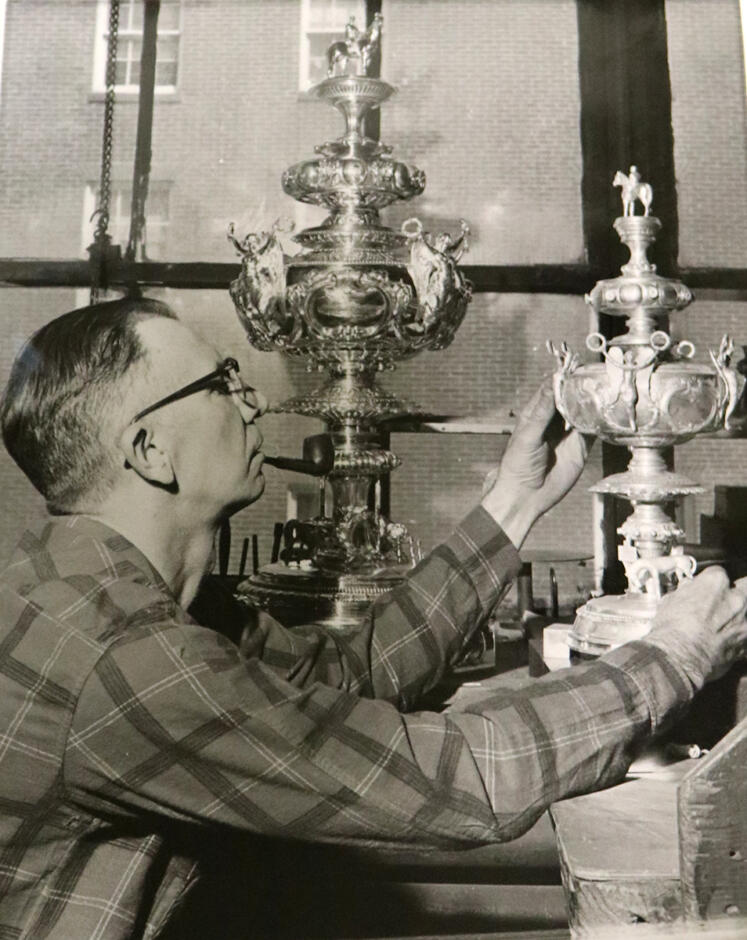
The Woodlawn Vase is the most valuable trophy in American sports and is housed at the Baltimore Museum of Art while a replica is given to the Preakness winner each year. (photo provided by the Maryland Jockey Club)
Preakness Stakes Traditions
The spontaneous exuberance of the Preakness’ return to Maryland in 1909 inspired a bugler, moved by the spirit of the day, to play Maryland’s historic state song “Maryland, My Maryland” with the full band and a celebratory crowd joining in enthusiastically. For over two decades, this musical honor has been performed by the United States Naval Academy Glee Club, patriotically attired in full dress whites.
From 1870 through 1966, Pimlico’s “Old Clubhouse,” a sprawling and elegant Victorian structure painted yellow with white trim and green shutters, defined a racing era that has ridden into the sunset. It was the place to see and be seen; no need for a dress code. Gentlemen were attired in business suits or tweed sports coats, ladies the latest fashions in dress and millinery. White-coated waiters and a tuxedoed maître d’ served customers. The jovial atmosphere was one of elegance and storied reminiscences, racing heirlooms and cherished memories. Though destroyed by fire in 1966, a whisper of Pimlico’s Old Clubhouse survives today in three respected practices, the painting of the weather vane atop the infield cupola replica, the Alibi Breakfast and all jockeys’ ubiquitous reference to the first turn past the finish line as the “Clubhouse Turn.”
The 1909 revival also inspired the ritual of painting the winning owner’s silks on the Old Clubhouse weather vane, christened by 1909 winner Effendi. After the original arrow-shaped weather vane was destroyed by lightning the same year, the Maryland Jockey Club commissioned a local iron worker to produce the now universally recognized horse and rider, which remains one of the fire’s few surviving items of heritage and stands on proud display in Pimlico’s “Hoofbeats Through History” exhibit. A replica of the Old Clubhouse was built in the infield – the cupola – and each year, for fans world wide, television cameras capture the painting of the winning colors and saddlecloth number, which proudly stand in homage to the victor until next year’s Preakness. Former painter, Michael Willinger, once acknowledged, “Let’s face it…It’s the only televised sign-painting job in the country!” Renowned artist Leroy Neiman performed the honors to commemorate the 125th Preakness in 2000.
One of Preakness week’s favorite traditions, Thursday’s Alibi Breakfast, has roots in the heyday of the Old Clubhouse, when trainers, owners, and racing enthusiasts gathered to chat and boast the merits of their horses. They “offered no alibis,” but swapped some of racing’s best stories, fiction and fact. Today’s Alibi Breakfast gathers media, horsemen and guests to celebrate the Preakness and honor those in racing.
A garland of roses adorns the Derby winner, carnations the Belmont. Since Bimelech in 1940, spectacular Gerber daisies, their centers blackened by shoe polish, pose as Black-eyed Susans, Maryland’s state flower since 1918 – its 13 petals representing 13 colonies – and the official flower of Preakness for the past 79 years. Today’s blanket is provided by Giant Food, which dedicates four people working eight hours to complete the 18” by 90” floral blanket. The flowers gifted to the winning connections during the trophy presentation are, however, real Black-eyed Susans, grown in a hot house before their natural June bloom!
The Woodlawn Vase is the most valuable trophy in American sports, a priceless, spectacular masterpiece of sterling silver, with the lost art of a craftsman’s intricate detail. Standing 3’ high and weighing 29 lbs, commissioned by Tiffany & Co. in 1860, the Vase was a challenge cup in Kentucky prior to the American Civil War. It was famously buried in the Kentucky dirt from 1861-1865 to escape capture and being melted into shot. By 1917, the Vase made its way to Maryland, where it became the perpetual trophy for the Preakness until 1953, when its historic value inspired Native Dancer’s owner, Mrs. Vanderbilt, to graciously suggest it remain with the MJC. A $30,000 smaller, sterling replica is now given to the winner each year. The Woodlawn Vase, a popular attraction at the Baltimore Museum of Art, returns to Old Hilltop every Preakness Day to occupy a position front and center on the cupola during national television. It is encased in glass for protection following a year or two when the Vase found itself tossed about during especially enthusiastic trophy presentations – repairs require a long road trip under armed guard to the only remaining silversmith qualified to handle the delicate job.
Continuing the Tradition
It has been said the annual renewal of the Preakness Stakes in Maryland every third Saturday in May is like having a Super Bowl and World Series, every year. Similar to kids in a family with unique personalities, each of the three Triple Crown races differs in its brand and appeal. While celebrities walk the red carpet, and the Preakness Corporate Village entertains Fortune 500 companies in the most elegant of settings, the Preakness is really known for its warmth, vitality and fun, where tradition and protocol are part of the celebration without restricting it, and the horsemen fondly credit Pimlico’s Horsemen’s Relations in welcoming them with racing’s best hospitality.
InfieldFest, launched in 2009 when Pimlico joined other sports venues in restricting BYOB, has hosted music’s biggest stars, including Zac Brown Band, Maroon 5, Bruno Mars, Florida Georgia Line, Little Big Town, Pitbull, Lorde, The Chainsmokers, Sam Hunt and Post Malone. Known for years as “The People’s Race…the People’s Party,” the Preakness is first and foremost, a classic race that challenges the finest three-year-olds and the world’s best jockeys to thrilling competition. But the appeal extends beyond, offering a lifestyle experience one can only discover every third Saturday in May. At Preakness, you see history, you are a part of history. As former General Manger Chick Lang said, “Before you go to Heaven, you got to make one stop at Hayward and Park Heights to see the Preakness, because that is what it’s all about.”
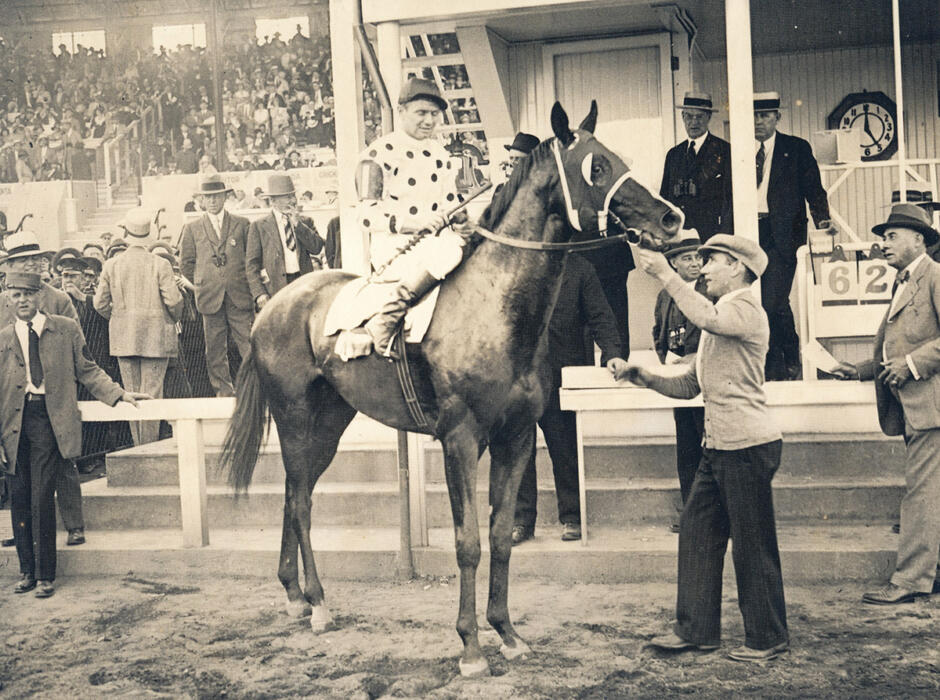
The 1930 Preakness winner Gallant Fox, owned by Maryland’s Belair Stud, went on to win the Triple Crown. He also fathered 1935 Triple Crown winner Belair Stud’s Omaha. (Courtesy of the City of Bowie Museums)
The Triple Crown
The phrase “Triple Crown” was bantered about informally until 1935, when popular sports writer Charles Hatton officially coined the term for simplicity’s sake for the Derby, Preakness and Belmont when reporting on Gallant Fox and his son, Omaha, as 1930 and 1935 Triple Crown winners, respectively. It was just simply easier to write!
The business entity, Triple Crown Productions, was created in 1985 by the three tracks after a serious assault on the racing tradition was launched by Bob Brennan, who rebuilt Garden State Park for $170,000,000 into what was considered a state of the art facility at the time. Brennan offered a $2,000,000 bonus for his Jersey Derby, luring the 1985 Derby winner, Spend A Buck, to skip the Preakness. However, with no Triple Crown corporate sponsor to fund a competitive bonus, the situation became critical when Brennan enticed Preakness winner, Snow Chief, to skip a show down with Derby winner, Ferdinand, in the 1986 Belmont. Writing for the L.A. Times, Bill Christine remarked: “The Triple Crown tracks have organized to fight Brennan, but they have moved slowly and have yet to capitalize on more than 100 years of tradition.
Brennan…always seems to be a step ahead, a horse in front and a thinker whose ideas put Churchill Downs and company on the defensive.”
The Maryland Jockey Club brought Chrysler to the table to fund the largest corporate sponsorship in US Thoroughbred racing at the time, the Chrysler Triple Crown Challenge, in 1987, offering a $5,000,000 bonus to the horse sweeping all three races, and a points-based $1,000,000 bonus, paid annually, to a horse competing in all three races. Chrysler served as Triple Crown title sponsor through 1995. Visa took over in 1996 and continued its sponsorship until 2005. There has not been another Triple Crown title sponsor since Visa.
Of the Triple Crown races, the Preakness Stakes has something exclusive – the first public appearance of the Derby winner – and it alone sets up the exciting potential for a possible Triple Crown. Far from any middle child syndrome, strategically, it is the glue that binds the three races together, the cream, if you will, in the proverbial Oreo cookie!
With homage to the great Triple Crown winners, American Pharoah and Justify, the 1989 Preakness was my favorite, not only because of the epic, dramatic stretch battle between Sunday Silence and Easy Goer, but it was the last Preakness with my Dad, before he died in August. The lasting energy and power of that contest between those two champions was never more evident than at a special evening Preakness Week at Washington, DC’s, Ronald Reagan Building, when 11 years later, that Preakness race replay brought the audience to its feet, clapping, cheering and gasping, even though every single person knew the outcome.
That is what Preakness is to the people.
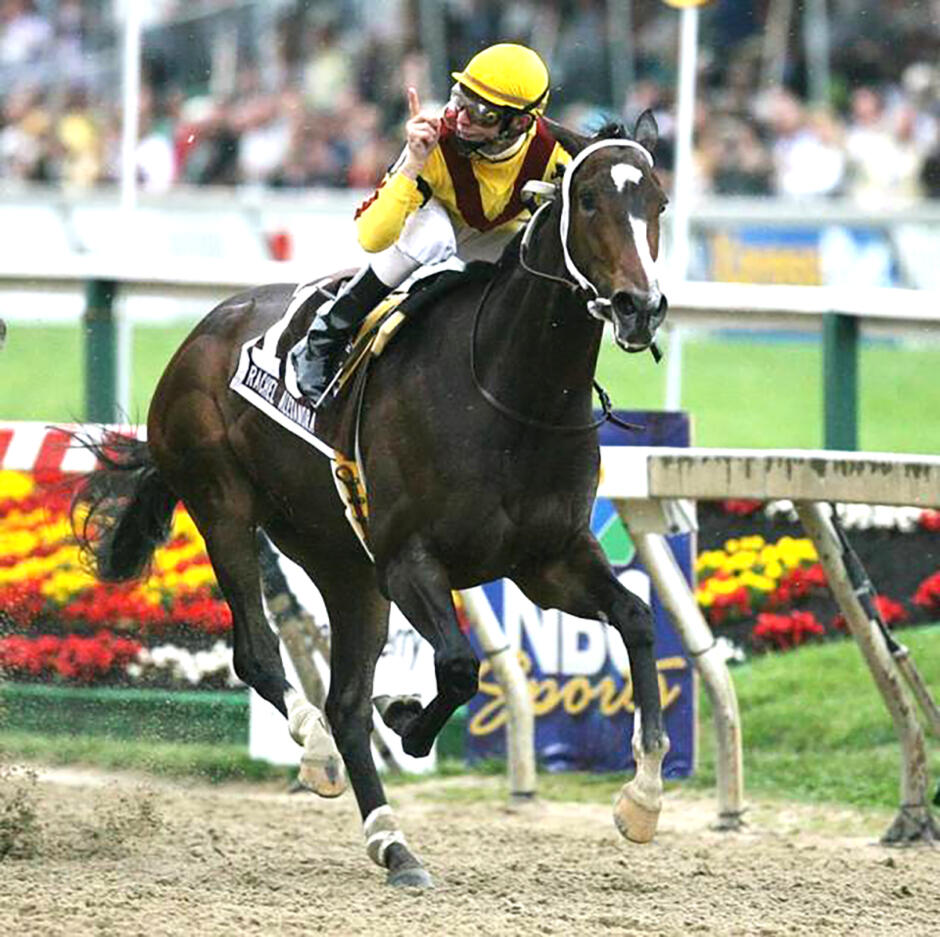
In 2009 Rachel Alexandra became the first filly since 1924 to win the Preakness Stakes. (photo by Jim McCue)
Preakness Stakes Facts & Stats
Since its inception, the Preakness has been run on every day of the week except for Sunday, including 14 times on Tuesdays! In 1945, the June 9 Kentucky Derby was followed only seven days later by the Preakness, the only time the Preakness was run in June.
It has been carded at seven different distances: 1.5 miles, 1 1/16, 1 1/4, 1m 70 yards, 1 mile, 1 1/8, and currently, 1 3/16. In 1918, 26 horses were entered, causing the Race to be run in two divisions for the first and only time in history. Today, the Preakness welcomes up to 14 contenders.
Secretariat holds the record for the fastest Preakness Stakes. At a special hearing, the Maryland Racing Commission unanimously voted in 2012 to officially change the prior 1:54 2/5 to a flat 1:53, after modern technology disputed flawed reporting in the electronic timer then in use, also contradicted by two independent DRF clockers hand-timing the race at 1:53 2/5.
Rachel Alexandra in 2009 became the first filly to win since Nellie Morse in 1924. Three other fillies have won, in 1903 (Flocarline), 1906 (Whimsical) and 1915 (Rhine Maiden). In total, 54 fillies have competed with perhaps Kentucky Derby winner Genuine Risk’s second place finish to Codex’s controversial win where he was accused of carrying Genuine Risk wide on the turn for home, being one of the most contentious.
A tip for handicapping by superstition: more than half of all Preakness winners have been bay, only three gray, including the indomitable “Gray Ghost” of Sagamore, Native Dancer.
Looking for more great photos from the Maryland Jockey Club’s archives? Follow The Equiery on Facebook!



